[EN - ES] Supracellular level of animal tissues ❀ Nivel supracelular de tejidos animales
Respectable readers, continuing with the theme of Natural Sciences, we continue explaining the supracellular structures constituted by animal tissues. The evident difference between plant and animal tissues, in addition to their functional specialization, is reflected.
Respetables lectores, continuando con el tema de las Ciencias Naturales, se prosigue explicando las estructuras supracelulares constituidas por los tejidos animales. Se deja reflejar la evidente diferencia entre los tejidos vegetales de los animales, además de su especialización funcional.
Four types of animal tissues are presented: epithelial, connective, muscular and nervous; their characteristics and functions are presented, as well as the corresponding image of each one of them.
Se exponen cuatro clases de tejidos animales: epiteliales, conectivos, muscular y nervioso; de los cuales, se presenta sus características y funciones, además de reflejar la imagen correspondiente de cada uno de ellos.
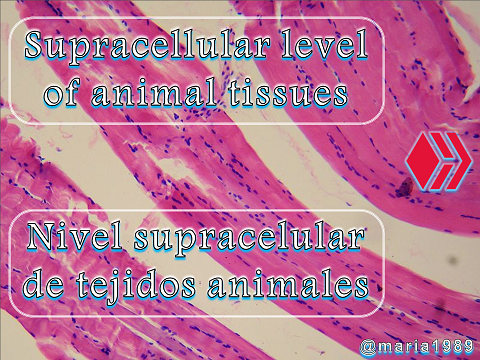
In animals, cell populations have undergone a profound process of differentiation and specialization that has led to the formation of multiple tissues of great structural complexity. These animal tissues are defined as follows:
En los animales, las poblaciones celulares han experimentado un profundo proceso de diferenciación y especialización que ha conducido a la formación de múltiples tejidos de gran complejidad estructural. En donde, esos tejidos animales se definen de la siguiente manera:
“…Tissues are structures composed of cells that perform specific functions in the body of an animal. Tissues may be composed of a single kind of cell or a mixture of several kinds of cells..." "...are formed from cells that are grouped together to give them shape. There are different types of animal tissues and each of them fulfills a specific function, in addition to the fact that the structure and origin is different in each case..." "...they can be divided into four types and all of them are found in most living beings belonging to the animal kingdom. These tissues are: epithelial, connective, muscular and nervous, all of which have different functions in animal organisms…”
“…Son estructuras compuestas de células que cumplen funciones específicas en el cuerpo de un animal. Los tejidos pueden estar compuestos de una sola clase de célula o de una mezcla de varias clases de células…” “…se forman a partir de células que se agrupan para darles forma. Hay distintos tipos de tejidos animales y cada uno de ellos cumple una función específica, además de que la estructura y el origen es distinta en cada caso...” “…se pueden dividir en cuatro tipos y todos ellos se encuentran en la mayoría de seres vivos que pertenecen al reino animal. Estos tejidos son: epiteliales, conectivos, musculares y nerviosos, todos cumplen funciones diferentes en los organismos animales…” ❀ Tejidos Animales
The following is the explanation and classification of the following tissues: epithelial, connective, muscular and nervous.
A continuación, se enumera la explicación y clasificación de los siguientes tejidos: epiteliales, conectivos, muscular y nervioso.

1) Epithelial tissue (tejido epithelial):

“…is the tissue formed by one or several layers of cells joined together, which, when placed on all the free surfaces of the organism, constitute the internal lining of the cavities, hollow organs, ducts of the body, as well as form the mucous membranes and glands..." "...The epithelial tissue derives from the three germinative layers: ectoderm, endoderm and mesoderm…”
“…es el tejido formado por una o varias capas de células unidas entre sí, que puestas recubren todas las superficies libres del organismo, y constituyen el revestimiento interno de las cavidades, órganos huecos, conductos del cuerpo, así como forman las mucosas y las glándulas…” “…El tejido epitelial deriva de las tres capas germinativas: ectodermo, endodermo y mesodermo…” ❀ Tejidos Epiteliales
Epithelial tissues cover both the external surface of the body and the interior cavities and form a continuous "tapestry" of cells. Within them, glands of many different types have also developed. These tissues present numerous specializations, depending on the areas they cover. There are pavement epithelia ("covering externally the skin or internally the ducts and hollow cavities of the organism, in which the epithelial cells are arranged in sheets"), of flat cells, which can be monostratified ("formed by a single layer"), such as the endothelia lining the blood vessels, in which there is a single cell layer, and multilayered, such as the mucous membranes, which cover those cavities and systems that open to the exterior (respiratory, digestive, genitourinary apparatus, etc. ) and the skin, which constitutes the Integumentary system or tissue.
Los tejidos epiteliales recubren tanto la superficie externa del cuerpo como las cavidades interiores y forman un “tapiz” continuo de células. En su seno se han desarrollado, además, glándulas de muy diverso tipo. Estos tejidos presentan numerosas especializaciones, según las zonas que recubran. Hay epitelios pavimentosos (“recubre externamente la piel o internamente los conductos y cavidades huecas del organismo, en el que las células epiteliales se disponen formando láminas”), de células planas, que pueden ser monoestratificados (“formados por una sola capa”), como los Endotelios que tapizan los vasos sanguíneos, en los cuales hay una sola capa celular, y pluriestratificados, como las Muxosas, que cubren aquellas cavidades y sistemas que se abren al exterior (aparato respiratorio, digestivo, genitourinario, etc.) y la piel, que constituye el sistema o Tejido Tegumentario.

Other epithelia are Vibratile and are characterized because their cells have a series of cilia, as occurs in the Tracheal Epithelium; they are Pseudostratified (there is a single cell layer but the nuclei are located at different levels). Plated epithelia have prismatic cells and protective structures that reduce wear and tear; they are found in the intestine. Finally, there are the Glandular Epithelia, formed by cubic cells that secrete different substances (goblet cells, mucous cells, etc.). The grouping of cellular elements forms the glands, which can discharge their secretions to the exterior (open glands), such as saliva, inside the organism itself (endocrine), such as the Thyroid or Thymus, or participate in both situations (mixed glands), such as the pancreas.
Otros epitelios son Vibrátiles y se caracterizan porque sus células poseen una serie de cilios, como ocurre en el Epitelio Traqueal; son Pseudoestratificados (hay una única capa celular pero los núcleos se sitúan a distintos niveles). Los Epitelios en chapa presentan células prismáticas y con estructuras protectoras que disminuyen su desgaste; se hallan en el intestino. Por último, están los Epitelios Glandulares, formados por células cúbicas que segregan diferentes sustancias (células caliciformes, mucosas, etc.). La agrupación de elementos celulares forma las glándulas, que pueden verter su secreción al exterior (glándulas abiertas), como la saliva, dentro del propio organismo (endocrinas), como el Tiroides o el Timo, o participar de las dos situaciones (glándulas mixtas), como el páncreas.
2) Connective tissue (tejido conectivo):
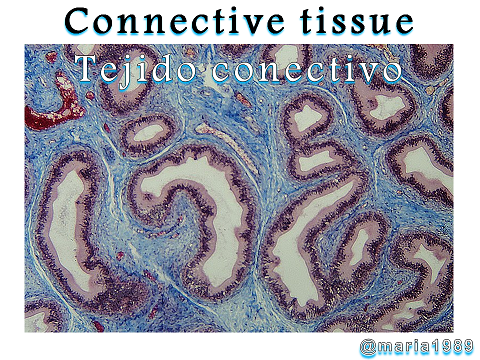
Epididymis section. Connective tissue (blue) is seen holding the epithelium (purple)
Sección de Epidídimo. Se observa el tejido conectivo (azul) sujetando al epitelio (púrpura)
“…connective tissue (CT), also called connective tissue, is a heterogeneous set of organic tissues that share a common origin from the embryonic mesenchyme originating from the mesoderm..."..." "... connective tissues concur in the primary function of support and systemic integration of the organism. In this way, the CT participates in the cohesion or separation of the different tissue elements that compose the organs and systems and also becomes a logistic means through which the vasculonervous structures are distributed…”
“…el tejido conjuntivo (TC), también llamado tejido conectivo, es un conjunto heterogéneo de tejidos orgánicos que comparten un origen común a partir del mesénquima embrionario originado a partir del mesodermo…” “… los tejidos conjuntivos concurren en la función primordial de sostén e integración sistémica del organismo. De esta forma, el TC participa en la cohesión o separación de los diferentes elementos tisulares que componen los órganos y sistemas y también se convierte en un medio logístico a través del cual se distribuyen las estructuras vasculonerviosas…” ❀ Tejidos Conectivos
Connective tissues relate some organs to others, envelop, reinforce, protect and, at the same time, serve as support and support for them. They include connective, cartilaginous, adipose, osseous and a very specialized variety of tissues, such as blood tissue.
Los tejidos conectivos relacionan unos órganos con otros, los envuelven, refuerzan, protegen y, al mismo tiempo, sirven de soporte y sostén para los mismos. En ellos se incluyen los tejidos: conjuntivo, cartilaginoso, adiposo, óseo, y una variedad muy especializada, como el tejido sanguíneo.
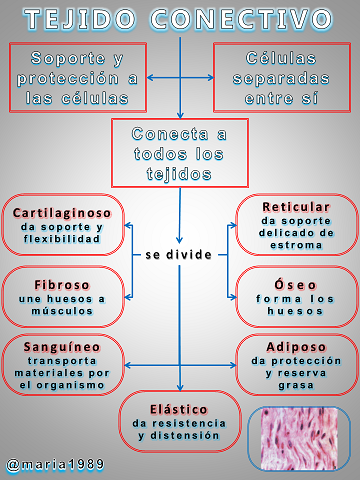
Connective Tissue (tejido conjuntivo)
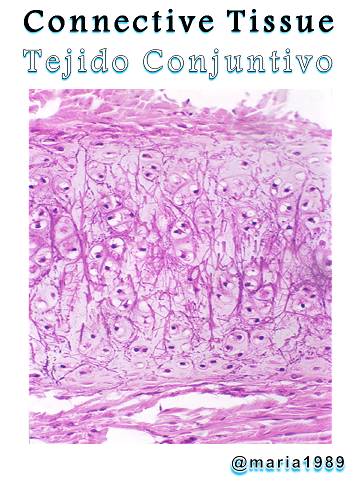
It is composed of a matrix and different types of cells. The matrix is made up of collagen fibers, constituted by a fibrous protein, tropocollagen; elastic fibers, elastin; and a set of mucoproteins and mucopolysaccharides. Among the cellular elements are fibroblasts, with numerous cytoplasmic prolongations; histiocytes, macrophages of amoeboid form; and a series of chromatophages, adipose cells, primed cells, etc. Connective tissue presents a large number of varieties, such as lax, dense and elastic connective tissue.
Se compone de una matriz y diferentes tipos de células. La matriz la integran Fibras Colagenas, constituidas por una proteína fibrosa, el tropocolágeno; Fibras Elásticas, de elastina; y un conjunto de mucoproteínas y mucopolisacáridos. Entre los elementos celulares destacan los fibroblastos, con numerosas prolongaciones citoplasmáticas; los histiocitos, macrófagos de forma ameboide; y una serie de cromatófagos, células adiposas, cebadas, etc. El tejido conjuntivo presenta un gran número de variedades, como el conjuntivo laxo, el denso y el elástico.
Cartilaginous Tissue (tejido cartilaginoso)
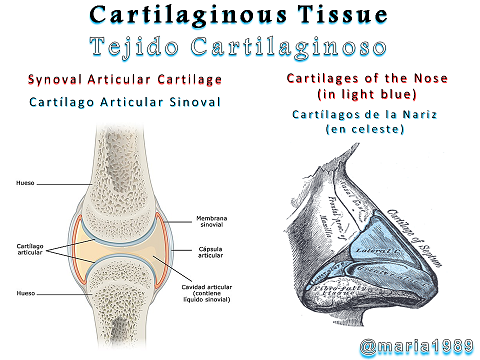
It has a solid matrix that isolates and confines the chondrocytes or cartilage cells in lacunae. It constitutes an important part of the endoskeleton of vertebrates.
Tiene una matriz sólida que aísla y confina en lagunas a los Condrocitos o células del cartílago. Constituye una parte importante del endoesqueleto de los vertebrados.
Adipose Tissue (tejido adiposo)

It is composed of numerous fat-laden cells, the adipocytes, which represent a store of reserves of the first order. They abound mainly in the marrow of bones and in the adipose panniculus of mammals.
Se compone de numerosas células cargadas de grasa, los Adipocitos, que representan un almacén de reservas de primer orden. Abundan sobre todo en el tuétano de los huesos y en el panículo adiposo de los mamíferos.
Bone Tissue (tejido óseo)

Compact and spongy tissue (tejido compacto y tejido esponjoso)
It is composed of a multitude of branching cells, the Osteocytes, confined in bony lacunae by the bone matrix, which is solid and consists of Ostein, a protein impregnated with calcium phosphate salts. Osteocytes surround in concentric circles the Havers ducts, which are channels through which nerves and vessels penetrate the bone. The nutritive substances reach the bone cells from the Havers ducts through the so-called calcophore ducts, where the cytoplasmic cellular prolongations are found. The consistency and resistance of this tissue make it the fundamental element in the constitution of the vertebrate skeleton.
Lo integra una multitud de célula de aspecto ramificado, los Osteocitos, confinados en lagunas óseas por la matriz del hueso, la cual es sólida y está constituida por Osteína, una proteína impregnada de sales de fosfato cálcico. Los osteocitos rodean en círculos concéntricos a los Conductos de Havers, que son canales por donde penetran los nervios y vasos hasta el hueso. Las sustancias nutritivas llegan hasta las células óseas desde los conductos de Havers mediante los denominados conductos calcóforos, donde se hallan las prolongaciones citoplasmáticas celulares. La consistencia y resistencia de este tejido hacen de él el elemento fundamental en la constitución del esqueleto de los vertebrados.
Blood Tissue (tejido sanguíneo)
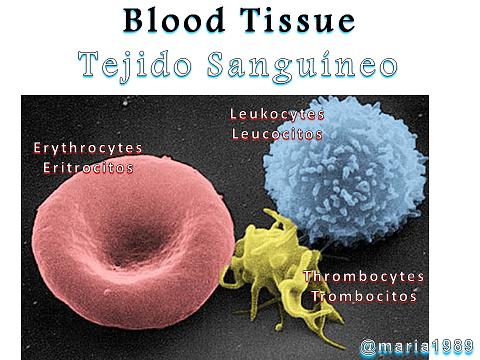
From left to right: erythrocytes, thrombocytes, leukocytes
De izquierda a derecha: eritrocitos, trombocitos, leucocitos
Blood is composed of a liquid part, the plasma, and a set of cellular elements. The plasma contains water, salts, ions, proteins, nutritive substances, hormones and a multitude of other molecules that form a colloidal solution in which the blood cells circulate. These are, in vertebrate animals, the red blood cells, which transport oxygen to the tissues of the organism thanks to the union of this with hemoglobin, the protein that gives the typical red color to the blood; Leukocytes or white blood cells, granular (basophils, eosinophils and neutrophils) and agranular (lymphocytes and menocytes), of primary importance in the defense of the organism against the invasion of external agents, and thrombocytes or platelets, which are involved in coagulation.
La sangre, se compone de una parte líquida, el plasma, y un conjunto de elementos celulares. El plasma contiene: agua, sales, iones, proteínas, sustancias nutritivas, hormonas y otra multitud de moléculas que forman una solución coloidal en cuyo seno circulan las células sanguíneas. Estas son, en los animales vertebrados, los hematíes o glóbulos rojos, los cuales transportan el oxígeno a los tejidos del organismo gracias a la unión de éste con la Hemoglobina, proteína que confiere el típico color rojo a la sangre; los Leucocitos o glóbulos blancos, Granulosos (basófilos, eosinófilos y neutrófilos) y Agranulares (linfocitos y menocitos), de importancia primordial en la defensa del organismo contra la invasión de agentes exteriores, y los trombocitos o plaquetas, que intervienen en la coagulación.
3) Muscle tissue (tejido muscular):
Primary classification differentiates them into specialized and non-specialized
Clasificación primaria los diferencia en: especializados y no especializados
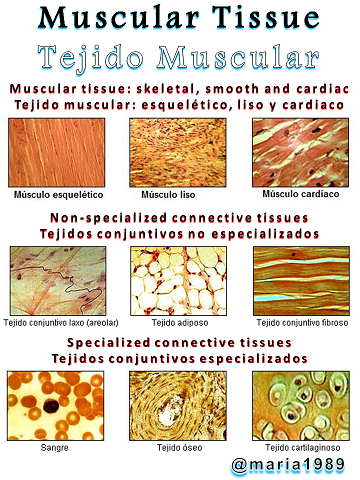
Muscular tissue: skeletal, smooth and cardiac (Tejido muscular: esquelético, liso y cardiaco)
Non-specialized connective tissues (Tejidos conjuntivos no especializados)
Specialized connective tissues (Tejidos conjuntivos especializados)
“…is made up of contractile cells called myocytes. The myocyte is a specialized cell that uses ATP (chemical energy) to generate movement thanks to the interaction of contractile proteins (actin and myosin)..." "...corresponds to approximately 40-50 % of the mass of human beings and is specialized in contraction, which allows living beings belonging to the animal kingdom to move…”
“…está formado por células contráctiles llamadas miocitos. El miocito es una célula especializada que utiliza ATP (energía química) para generar movimiento gracias a la interacción de las proteínas contráctiles (actina y miosina)…” “…corresponde aproximadamente el 40-50 % de la masa de los seres humanos y está especializado en la contracción, lo que permite que se muevan los seres vivos pertenecientes al reino animal…” ❀ Tejido Muscular
This tissue is formed by contractile proteins and allows, when it contracts, to move the bones, to which it is associated by tendons or other parts of the body. It is composed of two types of fibers: the smooth fibers, unicellular, whose contraction is involuntary and slow, which form the white musculature of the viscera, and the striated fibers, plurinucleated, of voluntary and rapid contraction, which constitute the skeletal muscles. The latter are actually bundles of striated fibers, which, in turn, are composed of fibrils, and these, by a multitude of filaments of two proteins, Actin and Myosin, which, when united, give rise to Actomyosin, capable of contracting. The process of muscle contraction is complex and also involves other proteins such as Thrombin, Tropomyosin, molecules such as ATP to supply energy, and ions such as Calcium (CA2+). The movement is produced by sliding some filaments over others and establishing temporary anchorage points between them that shorten the fiber and thicken it.
Este tejido está formado por proteínas contráctiles y permite, al contraerse ésta, mover los huesos, a los que va asociado mediante tendones u otras va asociado mediante tendones u otras partes del cuerpo. Lo componen dos tipos de fibras: las Fibras Lisas, unicelulares, cuya contracción es involuntaria y lenta, que forma la musculatura blanca de las vísceras, y las Fibras Estriadas, plurinucleadas, de contracción voluntaria y rápida, que constituyen los músculos esqueléticos. Estas últimas son en realidad haces de fibras estriadas, las cuales, a su vez, están integradas por fibrillas, y éstas, por multitud de filamentos de dos proteínas, Actina y Miosina que, al unirse, dan lugar a la Actomiosina, capaz de contraerse. El proceso de la contracción muscular es complejo y en él intervienen además otras proteínas como la Trombina, la Tropomiosina, moléculas como el ATP para suministrar energía, e iones como el Calcio (CA2+). El movimiento se produce al deslizar unos filamentos sobre otros y establecerse unos puntos de anclaje temporales entre ellos que acortan la fibra y la engruesan.
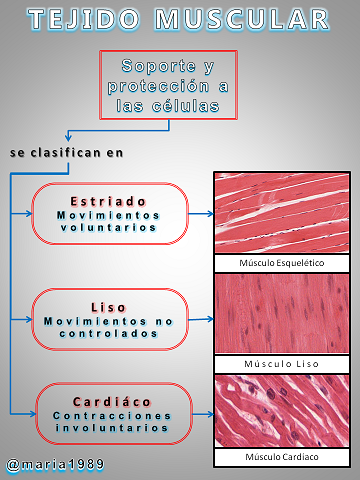
4) Nervous Tissue (tejido nervioso):

“…is a specialized tissue whose functional unit is the neuron. Neurons have specialized receptors to perceive different types of stimuli, whether mechanical, chemical, thermal, etc., and translate them into nerve impulses that will conduct them to nerve centers. These impulses propagate successively to other neurons for processing and transmission to higher centers to perceive sensations or initiate motor reactions…”
“…es un tejido especializado cuya unidad funcional es la neurona. Las neuronas tienen receptores especializados para percibir diferentes tipos de estímulos ya sean mecánicos, químicos, térmicos, etc, y traducirlos en impulsos nerviosos que lo conducirán a los centros nerviosos. Estos impulsos se propagan sucesivamente a otras neuronas para procesamiento y transmisión a los centros más altos y percibir sensaciones o iniciar reacciones motoras…” Tejido Nervioso
It is one of the most specialized tissues that exist and its function is to relate the animal with the surrounding environment and coordinate the movements and actions of the organism. The basic unit is the nerve cell or neuron, whose cytoplasm emits one or more nerve impulse receptor prolongations, the Dendrites, and another thinner one, which can reach great length, which transmits it, the Axon. In this way, the neurons are connected to each other in the so-called Synapses, and circuits of great complexity are configured, since the impulses coming from one cell can activate, inhibit or modulate the response of the receptor cell and this, in turn, influence the action of those that follow it.
Es uno de los tejidos más especializados que existen y su función consiste en relacionar al animal con el medio que lo rodea y coordinar los movimientos y acciones del organismo. La unidad básica es la célula nerviosa o Neurona, cuyo citoplasma emite una o varias prolongaciones receptoras del impulso nervioso, las Dendritas, y otra más fina, que puede alcanzar gran longitud, que lo transmite, el Axón. De esta forma se conectan entre sí las neuronas en las denominadas Sinapsis, y llegan a configurarse circuitos de gran complejidad, ya que los impulsos procedentes de una célula pueden activar, inhibir o modular la respuesta de la receptora y ésta, a su vez, influir en la acción de las que la siguen.
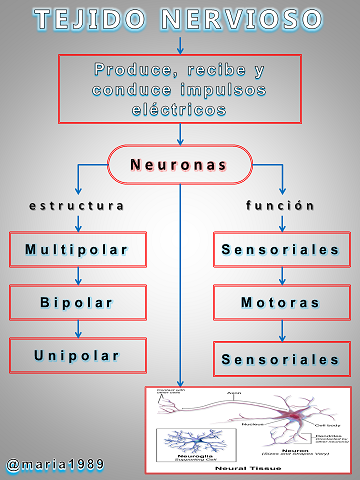
The nerve impulse is transmitted by a variation of the membrane potential of the neuron along the whole length of the neuron, which determines a depolarization of the neuron. Sodium ions (Na+) enter in great number and Potassium ions (K+) leave. The neuronal bodies are grouped to form nerve centers or masses of gray matter, while the axons are associated and give rise to the nerves, which are usually protected by an insulating outer sheath, formed by lipids, called Myelin. Accompanying the neurons there are also groups of supporting and nourishing cells, which constitute the Neurology.
El impulso nervioso se trasmite por una variación del potencial de membrana de la neurona a todo lo largo de la misma, lo que determina una despolarización en ella. Entran iones Sodio (Na+) en gran número y salen iones Potasio (K+). Los cuerpos neuronales se agrupan para formar centros nerviosos o masas de sustancia gris, mientras que los axones se asocian y dan lugar a los Nervios, que suelen ir protegidos por una vaina externa aislante, formada por lípidos, llamada Mielina. Acompañando a las neuronas aparecen también conjuntos de células de sostén y con papel nutricio, que constituyen la Neurología.
Pleased with your kind attention !
¡ Complacida por su amable atención !
❀@maria1989❀

Articles consulted (artículos de consulta):
❀ Animal tissue (Tejido Animal)
❀ Animals tissues (Tejidos Animales)
❀ Animal and vegetable tissues (Tejidos animales y vegetales)
❀ Animal tissue human anatomy (Tejido animal anatomía humana)
Thanks for your contribution to the STEMsocial community. Feel free to join us on discord to get to know the rest of us!
Please consider delegating to the @stemsocial account (85% of the curation rewards are returned).
You may also include @stemsocial as a beneficiary of the rewards of this post to get a stronger support.
Congratulations @maria1989! You have completed the following achievement on the Hive blockchain and have been rewarded with new badge(s):
Your next target is to reach 4000 upvotes.
You can view your badges on your board and compare yourself to others in the Ranking
If you no longer want to receive notifications, reply to this comment with the word
STOPCheck out the last post from @hivebuzz:
Support the HiveBuzz project. Vote for our proposal!
Es una excelente investigación que has logrado plasmar en tu publicación. Presentas unas imágenes bién logradas. Te felicito y que Dios te siga bendiciendo. Amén